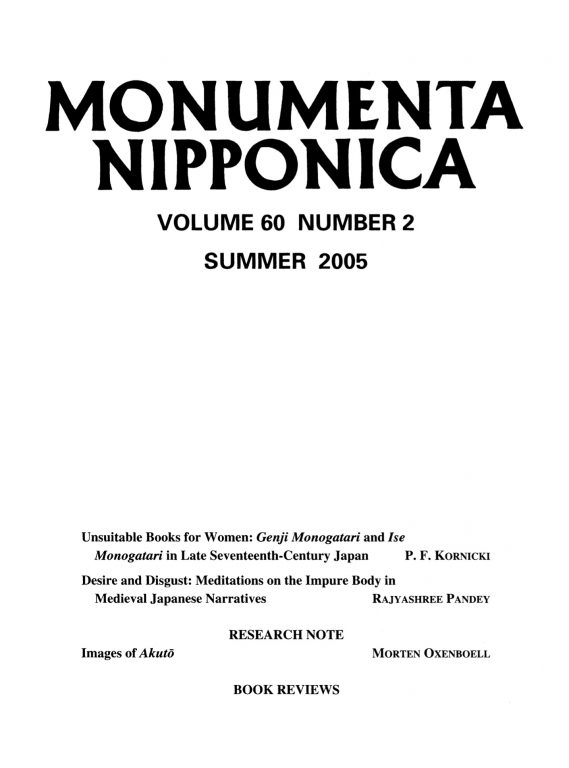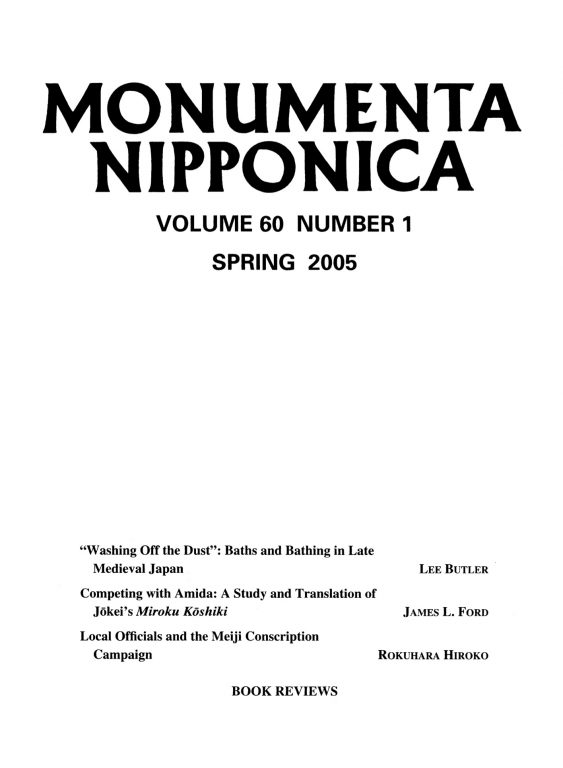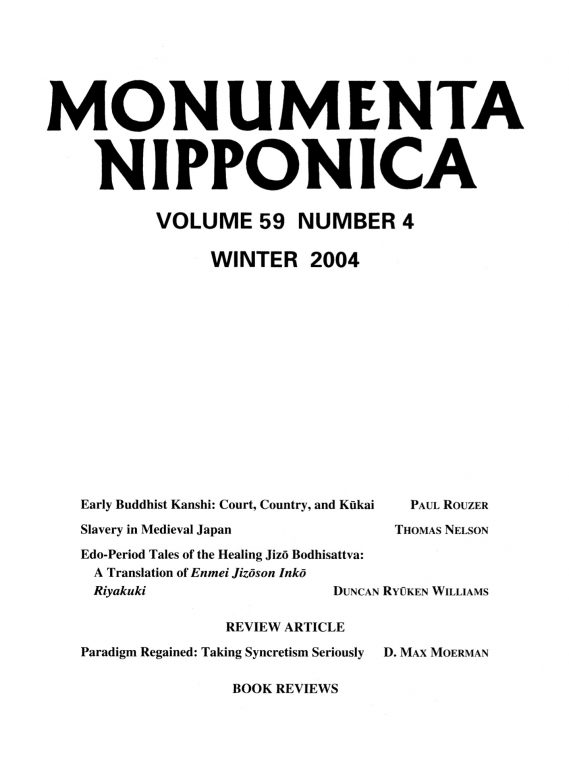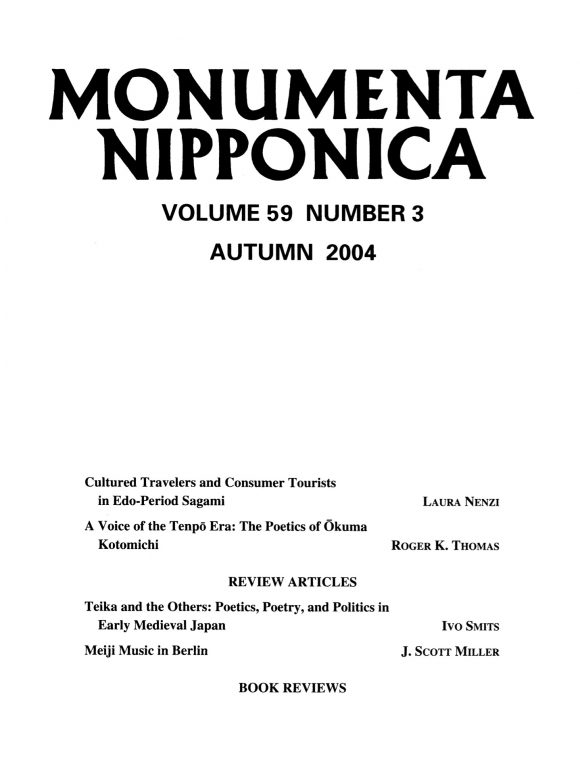Founded in 1938 and published semiannually by Sophia University MN 60:3 (2005) 434–36The Japanese Self in Cultural Logic by Takie Sugiyama LebraHarumi Befu
MN 60:3 (2005) 434–36The Japanese Self in Cultural Logic by Takie Sugiyama LebraHarumi Befu MN 60:2 (2005) 263–64The Tōkaidō Road: Traveling and Representation in Edo and Meiji Japan by Jilly TraganouLawrence E. Marceau
MN 60:2 (2005) 263–64The Tōkaidō Road: Traveling and Representation in Edo and Meiji Japan by Jilly TraganouLawrence E. Marceau MN 60:2 (2005) 265–67Interracial Intimacy in Japan: Western Men and Japanese Women, 1543–1900 by Gary P. LeuppSusan L. Burns
MN 60:2 (2005) 265–67Interracial Intimacy in Japan: Western Men and Japanese Women, 1543–1900 by Gary P. LeuppSusan L. Burns MN 60:2 (2005) 267–69Japan’s Early Experience of Contract Management in the Treaty Ports by Yuki Allyson HonjoJunko Ando
MN 60:2 (2005) 267–69Japan’s Early Experience of Contract Management in the Treaty Ports by Yuki Allyson HonjoJunko Ando MN 60:2 (2005) 269–72Hiratsuka Raichō and Early Japanese Feminism by Hiroko TomidaAndrea Germer
MN 60:2 (2005) 269–72Hiratsuka Raichō and Early Japanese Feminism by Hiroko TomidaAndrea Germer MN 60:2 (2005) 272–75Historische Frauenforschung in Japan: Die Rekonstruktion der Vergangenheit in Takamure Itsues “Geschichte der Frau” (Josei no rekishi) by Andrea GermerUlrike Wöhr
MN 60:2 (2005) 272–75Historische Frauenforschung in Japan: Die Rekonstruktion der Vergangenheit in Takamure Itsues “Geschichte der Frau” (Josei no rekishi) by Andrea GermerUlrike Wöhr MN 60:2 (2005) 275–78At the House of Gathered Leaves: Short Biographical and Autobiographical Narratives from Japanese Court Literature by Joshua S. MostowLynne K. Miyake
MN 60:2 (2005) 275–78At the House of Gathered Leaves: Short Biographical and Autobiographical Narratives from Japanese Court Literature by Joshua S. MostowLynne K. Miyake MN 60:2 (2005) 278–81Writing Home: Representations of the Native Place in Modern Japanese Literature by Stephen DoddDennis Washburn
MN 60:2 (2005) 278–81Writing Home: Representations of the Native Place in Modern Japanese Literature by Stephen DoddDennis Washburn MN 60:2 (2005) 281–83The Body in Postwar Japanese Fiction by Douglas N. SlaymakerJoseph S. O'Leary
MN 60:2 (2005) 281–83The Body in Postwar Japanese Fiction by Douglas N. SlaymakerJoseph S. O'Leary MN 60:2 (2005) 283–88Keigo in Modern Japan: Polite Language from Meiji to the Present by Patricia J. Wetzel; Rhetoric in Modern Japan: Western Influences on the Development of Narrative and Oratorical Style by Massimiliano TomasiNanette Gottlieb
MN 60:2 (2005) 283–88Keigo in Modern Japan: Polite Language from Meiji to the Present by Patricia J. Wetzel; Rhetoric in Modern Japan: Western Influences on the Development of Narrative and Oratorical Style by Massimiliano TomasiNanette Gottlieb MN 60:2 (2005) 288–90Tsukiji: The Fish Market at the Center of the World by Theodore BestorAnne Allison
MN 60:2 (2005) 288–90Tsukiji: The Fish Market at the Center of the World by Theodore BestorAnne Allison MN 60:2 (2005) 290–93Identity and Ritual in a Japanese Diving Village: The Making and Becoming of Person and Place by D. P. MartinezBirgit Staemmler
MN 60:2 (2005) 290–93Identity and Ritual in a Japanese Diving Village: The Making and Becoming of Person and Place by D. P. MartinezBirgit Staemmler MN 60:2 (2005) 293–95The Koto: A Traditional Instrument in Contemporary Japan by Henry JohnsonDavid Waterhouse
MN 60:2 (2005) 293–95The Koto: A Traditional Instrument in Contemporary Japan by Henry JohnsonDavid Waterhouse MN 60:1 (2005) 111–12House and Home in Modern Japan: Reforming Everyday Life, 1880–1930 by Jordan SandAnn Waswo
MN 60:1 (2005) 111–12House and Home in Modern Japan: Reforming Everyday Life, 1880–1930 by Jordan SandAnn Waswo MN 60:1 (2005) 112–15Frauenerziehung und Frauenbild im Umbruch: Ideale von Mädchenerziehung, Frauenrolle und weiblichen Lebensentwürfen in der frühen Jogaku zasshi (1885–1889) by Nadja Kischka-WellhäusserMargaret Mehl
MN 60:1 (2005) 112–15Frauenerziehung und Frauenbild im Umbruch: Ideale von Mädchenerziehung, Frauenrolle und weiblichen Lebensentwürfen in der frühen Jogaku zasshi (1885–1889) by Nadja Kischka-WellhäusserMargaret Mehl MN 60:1 (2005) 115–18Women and the Labour Market in Japan’s Industrialising Economy: The Textile Industry before the Pacific War by Janet HunterBarbara Molony
MN 60:1 (2005) 115–18Women and the Labour Market in Japan’s Industrialising Economy: The Textile Industry before the Pacific War by Janet HunterBarbara Molony MN 60:1 (2005) 118–21Colonizing Sex: Sexology and Social Control in Modern Japan by Sabine FrühstückSally Ann Hastings
MN 60:1 (2005) 118–21Colonizing Sex: Sexology and Social Control in Modern Japan by Sabine FrühstückSally Ann Hastings MN 60:1 (2005) 121–23Toshié: A Story of Village Life in Twentieth-Century Japan by Simon PartnerMariko Asano Tamanoi
MN 60:1 (2005) 121–23Toshié: A Story of Village Life in Twentieth-Century Japan by Simon PartnerMariko Asano Tamanoi MN 60:1 (2005) 123–28Practicing the Afterlife: Perspectives from Japan ed. Susanne Formanek, William LaFleur; Bereavement and Consolation: Testimonies from Tokugawa Japan by Harold BolithoFabio Rambelli
MN 60:1 (2005) 123–28Practicing the Afterlife: Perspectives from Japan ed. Susanne Formanek, William LaFleur; Bereavement and Consolation: Testimonies from Tokugawa Japan by Harold BolithoFabio Rambelli MN 60:1 (2005) 128–31Practical Pursuits: Religion, Politics, and Personal Cultivation in Nineteenth-Century Japan by Janine Tasca SawadaBarbara Ambros
MN 60:1 (2005) 128–31Practical Pursuits: Religion, Politics, and Personal Cultivation in Nineteenth-Century Japan by Janine Tasca SawadaBarbara Ambros MN 60:1 (2005) 131–34Gender and National Literature: Heian Texts in the Constructions of Japanese Modernity by Tomiko YodaJoshua S. Mostow
MN 60:1 (2005) 131–34Gender and National Literature: Heian Texts in the Constructions of Japanese Modernity by Tomiko YodaJoshua S. Mostow MN 60:1 (2005) 134–37The Ethos of Noh: Actors and Their Art by Eric C. RathGerald Groemer
MN 60:1 (2005) 134–37The Ethos of Noh: Actors and Their Art by Eric C. RathGerald Groemer MN 60:1 (2005) 137–40Text and the City: Essays on Japanese Modernity by Maeda Ai, ed. James FujiiIrmela Hijiya-Kirschnereit
MN 60:1 (2005) 137–40Text and the City: Essays on Japanese Modernity by Maeda Ai, ed. James FujiiIrmela Hijiya-Kirschnereit MN 60:1 (2005) 140–43The Artist as Professional in Japan ed. Melinda TakeuchiQuitman E. Phillips
MN 60:1 (2005) 140–43The Artist as Professional in Japan ed. Melinda TakeuchiQuitman E. Phillips MN 60:1 (2005) 143–45Critical Perspectives on Classicism in Japanese Painting, 1600–1700 ed. Elizabeth LillehojFrank Chance
MN 60:1 (2005) 143–45Critical Perspectives on Classicism in Japanese Painting, 1600–1700 ed. Elizabeth LillehojFrank Chance MN 59:4 (2004) 535–538The Moneylenders of Late Medieval Kyoto by Suzanne GayAndrew Edmund Goble
MN 59:4 (2004) 535–538The Moneylenders of Late Medieval Kyoto by Suzanne GayAndrew Edmund Goble MN 59:4 (2004) 538–541Pre-Industrial Korea and Japan in Environmental Perspective by Conrad TotmanBruce L. Batten
MN 59:4 (2004) 538–541Pre-Industrial Korea and Japan in Environmental Perspective by Conrad TotmanBruce L. Batten MN 59:4 (2004) 541–543Frontier Contact between Chosŏn Korea and Tokugawa Japan by James B. LewisDavid L. Howell
MN 59:4 (2004) 541–543Frontier Contact between Chosŏn Korea and Tokugawa Japan by James B. LewisDavid L. Howell MN 59:4 (2004) 544–546Japans Karneval der Krise: Ējanaika und die Meiji-Renovation by Reinhard ZöllnerKlaus Antoni
MN 59:4 (2004) 544–546Japans Karneval der Krise: Ējanaika und die Meiji-Renovation by Reinhard ZöllnerKlaus Antoni MN 59:4 (2004) 547–549Divorce in Japan: Family, Gender, and the State, 1600–2000 by Harald FuessGail Lee Bernstein
MN 59:4 (2004) 547–549Divorce in Japan: Family, Gender, and the State, 1600–2000 by Harald FuessGail Lee Bernstein MN 59:4 (2004) 549–552A Vision of Empire: Kita Ikki and the Making of Modern Japan by Brij TankhaBen-Ami Shillony
MN 59:4 (2004) 549–552A Vision of Empire: Kita Ikki and the Making of Modern Japan by Brij TankhaBen-Ami Shillony MN 59:4 (2004) 552–555Novel Japan: Spaces of Nationhood in Early Meiji Narrative, 1870–88 by John Pierre MertzRichard Torrance
MN 59:4 (2004) 552–555Novel Japan: Spaces of Nationhood in Early Meiji Narrative, 1870–88 by John Pierre MertzRichard Torrance MN 59:4 (2004) 555–558The Dawn That Never Comes: Shimazaki Tōson and Japanese Nationalism by Michael K. BourdaghsChia-Ning Chang
MN 59:4 (2004) 555–558The Dawn That Never Comes: Shimazaki Tōson and Japanese Nationalism by Michael K. BourdaghsChia-Ning Chang MN 59:4 (2004) 558–561Under an Imperial Sun: Japanese Colonial Literature of Taiwan and the South by Faye Yuan KleemanMichael Molasky
MN 59:4 (2004) 558–561Under an Imperial Sun: Japanese Colonial Literature of Taiwan and the South by Faye Yuan KleemanMichael Molasky MN 59:4 (2004) 562–565Bodies of Evidence: Women, Society, and Detective Fiction in 1990s Japan by Amanda C. SeamanSharalyn Orbaugh
MN 59:4 (2004) 562–565Bodies of Evidence: Women, Society, and Detective Fiction in 1990s Japan by Amanda C. SeamanSharalyn Orbaugh MN 59:4 (2004) 565–567Orienting Arthur Waley: Japonism, Orientalism, and the Creation of Japanese Literature in English by John Walter de GruchyMachiko Midorikawa
MN 59:4 (2004) 565–567Orienting Arthur Waley: Japonism, Orientalism, and the Creation of Japanese Literature in English by John Walter de GruchyMachiko Midorikawa MN 59:4 (2004) 567–569The Prints of Isoda Koryūsai: Floating World Culture and Its Consumers in Eighteenth-Century Japan by Allen HockleyVictoria Weston
MN 59:4 (2004) 567–569The Prints of Isoda Koryūsai: Floating World Culture and Its Consumers in Eighteenth-Century Japan by Allen HockleyVictoria Weston MN 59:4 (2004) 569–572Japan’s Modern Theatre: A Century of Continuity and Change by Brian PowellPeter Eckersall
MN 59:4 (2004) 569–572Japan’s Modern Theatre: A Century of Continuity and Change by Brian PowellPeter Eckersall MN 59:4 (2004) 572–575Working Out in Japan: Shaping the Female Body in Tokyo Fitness Clubs by Laura SpielvogelWolfram Manzenreiter
MN 59:4 (2004) 572–575Working Out in Japan: Shaping the Female Body in Tokyo Fitness Clubs by Laura SpielvogelWolfram Manzenreiter MN 59:3 (2004) 395–97An Archaeological History of Japan 30,000 B.C. to A.D. 700 by Koji MizoguchiWalter Edwards
MN 59:3 (2004) 395–97An Archaeological History of Japan 30,000 B.C. to A.D. 700 by Koji MizoguchiWalter Edwards MN 59:3 (2004) 398–400Notes journalières de Fujiwara no Sukefusa: Traduction du Shunki by Francine HérailRoyall Tyler
MN 59:3 (2004) 398–400Notes journalières de Fujiwara no Sukefusa: Traduction du Shunki by Francine HérailRoyall Tyler MN 59:3 (2004) 400–403Private Academies of Chinese Learning in Meiji Japan: The Decline and Transformation of the Kangaku Juku by Margaret MehlBrian W. Platt
MN 59:3 (2004) 400–403Private Academies of Chinese Learning in Meiji Japan: The Decline and Transformation of the Kangaku Juku by Margaret MehlBrian W. Platt MN 59:3 (2004) 403–406The Rising Sun and the Turkish Crescent: New Perspectives on the History of Japanese Turkish Relations by Selçuk Esenbel, Inaba ChiharuIgor R. Saveliev
MN 59:3 (2004) 403–406The Rising Sun and the Turkish Crescent: New Perspectives on the History of Japanese Turkish Relations by Selçuk Esenbel, Inaba ChiharuIgor R. Saveliev MN 59:3 (2004) 406–409Alternative Narratives in Modern Japanese History by M. William SteeleKerry Smith
MN 59:3 (2004) 406–409Alternative Narratives in Modern Japanese History by M. William SteeleKerry Smith MN 59:3 (2004) 409–11Wer war Takeuchi Yoshimis Lu Xun? Ein Annäherungsversuch an ein Monument der japanischen Sinologie by Christian UhlHans Martin Krämer
MN 59:3 (2004) 409–11Wer war Takeuchi Yoshimis Lu Xun? Ein Annäherungsversuch an ein Monument der japanischen Sinologie by Christian UhlHans Martin Krämer MN 59:3 (2004) 411–14Just Living: Poems and Prose by the Japanese Monk Tonna by Steven D. CarterLinda H. Chance
MN 59:3 (2004) 411–14Just Living: Poems and Prose by the Japanese Monk Tonna by Steven D. CarterLinda H. Chance MN 59:3 (2004) 414–16Far Beyond the Field: Haiku by Japanese Women by Makoto UedaAnne Walthall
MN 59:3 (2004) 414–16Far Beyond the Field: Haiku by Japanese Women by Makoto UedaAnne Walthall MN 59:3 (2004) 416–18“Berichte über Gesehenes und Gehörtes aus der Ansei-Zeit” (Ansei kemmonshi): Kanagaki Robuns (1829–1894) Bericht über das grosse Ansei-Erdbeben 1855 als Repräsentant des Genres der “Katastrophendarstellungen” by Stephan Köhn; Das “Ehon Muro no Yashima” (1808): Edition und Analyse eines Kamigatayomihon by Ekkehard May, Martina Schönbein, Claudia Waltermann; Edo bunko: Die Edo Bibliothek by Ekkehard May, Martina Schönbein, John Schmitt-WeigandPeter F. Kornicki
MN 59:3 (2004) 416–18“Berichte über Gesehenes und Gehörtes aus der Ansei-Zeit” (Ansei kemmonshi): Kanagaki Robuns (1829–1894) Bericht über das grosse Ansei-Erdbeben 1855 als Repräsentant des Genres der “Katastrophendarstellungen” by Stephan Köhn; Das “Ehon Muro no Yashima” (1808): Edition und Analyse eines Kamigatayomihon by Ekkehard May, Martina Schönbein, Claudia Waltermann; Edo bunko: Die Edo Bibliothek by Ekkehard May, Martina Schönbein, John Schmitt-WeigandPeter F. Kornicki
 MN 60:3 (2005) 434–36The Japanese Self in Cultural Logic by Takie Sugiyama LebraHarumi Befu
MN 60:3 (2005) 434–36The Japanese Self in Cultural Logic by Takie Sugiyama LebraHarumi Befu MN 60:2 (2005) 263–64The Tōkaidō Road: Traveling and Representation in Edo and Meiji Japan by Jilly TraganouLawrence E. Marceau
MN 60:2 (2005) 263–64The Tōkaidō Road: Traveling and Representation in Edo and Meiji Japan by Jilly TraganouLawrence E. Marceau MN 60:2 (2005) 265–67Interracial Intimacy in Japan: Western Men and Japanese Women, 1543–1900 by Gary P. LeuppSusan L. Burns
MN 60:2 (2005) 265–67Interracial Intimacy in Japan: Western Men and Japanese Women, 1543–1900 by Gary P. LeuppSusan L. Burns MN 60:2 (2005) 267–69Japan’s Early Experience of Contract Management in the Treaty Ports by Yuki Allyson HonjoJunko Ando
MN 60:2 (2005) 267–69Japan’s Early Experience of Contract Management in the Treaty Ports by Yuki Allyson HonjoJunko Ando MN 60:2 (2005) 269–72Hiratsuka Raichō and Early Japanese Feminism by Hiroko TomidaAndrea Germer
MN 60:2 (2005) 269–72Hiratsuka Raichō and Early Japanese Feminism by Hiroko TomidaAndrea Germer MN 60:2 (2005) 272–75Historische Frauenforschung in Japan: Die Rekonstruktion der Vergangenheit in Takamure Itsues “Geschichte der Frau” (Josei no rekishi) by Andrea GermerUlrike Wöhr
MN 60:2 (2005) 272–75Historische Frauenforschung in Japan: Die Rekonstruktion der Vergangenheit in Takamure Itsues “Geschichte der Frau” (Josei no rekishi) by Andrea GermerUlrike Wöhr MN 60:2 (2005) 275–78At the House of Gathered Leaves: Short Biographical and Autobiographical Narratives from Japanese Court Literature by Joshua S. MostowLynne K. Miyake
MN 60:2 (2005) 275–78At the House of Gathered Leaves: Short Biographical and Autobiographical Narratives from Japanese Court Literature by Joshua S. MostowLynne K. Miyake MN 60:2 (2005) 278–81Writing Home: Representations of the Native Place in Modern Japanese Literature by Stephen DoddDennis Washburn
MN 60:2 (2005) 278–81Writing Home: Representations of the Native Place in Modern Japanese Literature by Stephen DoddDennis Washburn MN 60:2 (2005) 281–83The Body in Postwar Japanese Fiction by Douglas N. SlaymakerJoseph S. O'Leary
MN 60:2 (2005) 281–83The Body in Postwar Japanese Fiction by Douglas N. SlaymakerJoseph S. O'Leary MN 60:2 (2005) 283–88Keigo in Modern Japan: Polite Language from Meiji to the Present by Patricia J. Wetzel; Rhetoric in Modern Japan: Western Influences on the Development of Narrative and Oratorical Style by Massimiliano TomasiNanette Gottlieb
MN 60:2 (2005) 283–88Keigo in Modern Japan: Polite Language from Meiji to the Present by Patricia J. Wetzel; Rhetoric in Modern Japan: Western Influences on the Development of Narrative and Oratorical Style by Massimiliano TomasiNanette Gottlieb MN 60:2 (2005) 288–90Tsukiji: The Fish Market at the Center of the World by Theodore BestorAnne Allison
MN 60:2 (2005) 288–90Tsukiji: The Fish Market at the Center of the World by Theodore BestorAnne Allison MN 60:2 (2005) 290–93Identity and Ritual in a Japanese Diving Village: The Making and Becoming of Person and Place by D. P. MartinezBirgit Staemmler
MN 60:2 (2005) 290–93Identity and Ritual in a Japanese Diving Village: The Making and Becoming of Person and Place by D. P. MartinezBirgit Staemmler MN 60:2 (2005) 293–95The Koto: A Traditional Instrument in Contemporary Japan by Henry JohnsonDavid Waterhouse
MN 60:2 (2005) 293–95The Koto: A Traditional Instrument in Contemporary Japan by Henry JohnsonDavid Waterhouse MN 60:1 (2005) 111–12House and Home in Modern Japan: Reforming Everyday Life, 1880–1930 by Jordan SandAnn Waswo
MN 60:1 (2005) 111–12House and Home in Modern Japan: Reforming Everyday Life, 1880–1930 by Jordan SandAnn Waswo MN 60:1 (2005) 112–15Frauenerziehung und Frauenbild im Umbruch: Ideale von Mädchenerziehung, Frauenrolle und weiblichen Lebensentwürfen in der frühen Jogaku zasshi (1885–1889) by Nadja Kischka-WellhäusserMargaret Mehl
MN 60:1 (2005) 112–15Frauenerziehung und Frauenbild im Umbruch: Ideale von Mädchenerziehung, Frauenrolle und weiblichen Lebensentwürfen in der frühen Jogaku zasshi (1885–1889) by Nadja Kischka-WellhäusserMargaret Mehl MN 60:1 (2005) 115–18Women and the Labour Market in Japan’s Industrialising Economy: The Textile Industry before the Pacific War by Janet HunterBarbara Molony
MN 60:1 (2005) 115–18Women and the Labour Market in Japan’s Industrialising Economy: The Textile Industry before the Pacific War by Janet HunterBarbara Molony MN 60:1 (2005) 118–21Colonizing Sex: Sexology and Social Control in Modern Japan by Sabine FrühstückSally Ann Hastings
MN 60:1 (2005) 118–21Colonizing Sex: Sexology and Social Control in Modern Japan by Sabine FrühstückSally Ann Hastings MN 60:1 (2005) 121–23Toshié: A Story of Village Life in Twentieth-Century Japan by Simon PartnerMariko Asano Tamanoi
MN 60:1 (2005) 121–23Toshié: A Story of Village Life in Twentieth-Century Japan by Simon PartnerMariko Asano Tamanoi MN 60:1 (2005) 123–28Practicing the Afterlife: Perspectives from Japan ed. Susanne Formanek, William LaFleur; Bereavement and Consolation: Testimonies from Tokugawa Japan by Harold BolithoFabio Rambelli
MN 60:1 (2005) 123–28Practicing the Afterlife: Perspectives from Japan ed. Susanne Formanek, William LaFleur; Bereavement and Consolation: Testimonies from Tokugawa Japan by Harold BolithoFabio Rambelli MN 60:1 (2005) 128–31Practical Pursuits: Religion, Politics, and Personal Cultivation in Nineteenth-Century Japan by Janine Tasca SawadaBarbara Ambros
MN 60:1 (2005) 128–31Practical Pursuits: Religion, Politics, and Personal Cultivation in Nineteenth-Century Japan by Janine Tasca SawadaBarbara Ambros MN 60:1 (2005) 131–34Gender and National Literature: Heian Texts in the Constructions of Japanese Modernity by Tomiko YodaJoshua S. Mostow
MN 60:1 (2005) 131–34Gender and National Literature: Heian Texts in the Constructions of Japanese Modernity by Tomiko YodaJoshua S. Mostow MN 60:1 (2005) 134–37The Ethos of Noh: Actors and Their Art by Eric C. RathGerald Groemer
MN 60:1 (2005) 134–37The Ethos of Noh: Actors and Their Art by Eric C. RathGerald Groemer MN 60:1 (2005) 137–40Text and the City: Essays on Japanese Modernity by Maeda Ai, ed. James FujiiIrmela Hijiya-Kirschnereit
MN 60:1 (2005) 137–40Text and the City: Essays on Japanese Modernity by Maeda Ai, ed. James FujiiIrmela Hijiya-Kirschnereit MN 60:1 (2005) 140–43The Artist as Professional in Japan ed. Melinda TakeuchiQuitman E. Phillips
MN 60:1 (2005) 140–43The Artist as Professional in Japan ed. Melinda TakeuchiQuitman E. Phillips MN 60:1 (2005) 143–45Critical Perspectives on Classicism in Japanese Painting, 1600–1700 ed. Elizabeth LillehojFrank Chance
MN 60:1 (2005) 143–45Critical Perspectives on Classicism in Japanese Painting, 1600–1700 ed. Elizabeth LillehojFrank Chance MN 59:4 (2004) 535–538The Moneylenders of Late Medieval Kyoto by Suzanne GayAndrew Edmund Goble
MN 59:4 (2004) 535–538The Moneylenders of Late Medieval Kyoto by Suzanne GayAndrew Edmund Goble MN 59:4 (2004) 538–541Pre-Industrial Korea and Japan in Environmental Perspective by Conrad TotmanBruce L. Batten
MN 59:4 (2004) 538–541Pre-Industrial Korea and Japan in Environmental Perspective by Conrad TotmanBruce L. Batten MN 59:4 (2004) 541–543Frontier Contact between Chosŏn Korea and Tokugawa Japan by James B. LewisDavid L. Howell
MN 59:4 (2004) 541–543Frontier Contact between Chosŏn Korea and Tokugawa Japan by James B. LewisDavid L. Howell MN 59:4 (2004) 544–546Japans Karneval der Krise: Ējanaika und die Meiji-Renovation by Reinhard ZöllnerKlaus Antoni
MN 59:4 (2004) 544–546Japans Karneval der Krise: Ējanaika und die Meiji-Renovation by Reinhard ZöllnerKlaus Antoni MN 59:4 (2004) 547–549Divorce in Japan: Family, Gender, and the State, 1600–2000 by Harald FuessGail Lee Bernstein
MN 59:4 (2004) 547–549Divorce in Japan: Family, Gender, and the State, 1600–2000 by Harald FuessGail Lee Bernstein MN 59:4 (2004) 549–552A Vision of Empire: Kita Ikki and the Making of Modern Japan by Brij TankhaBen-Ami Shillony
MN 59:4 (2004) 549–552A Vision of Empire: Kita Ikki and the Making of Modern Japan by Brij TankhaBen-Ami Shillony MN 59:4 (2004) 552–555Novel Japan: Spaces of Nationhood in Early Meiji Narrative, 1870–88 by John Pierre MertzRichard Torrance
MN 59:4 (2004) 552–555Novel Japan: Spaces of Nationhood in Early Meiji Narrative, 1870–88 by John Pierre MertzRichard Torrance MN 59:4 (2004) 555–558The Dawn That Never Comes: Shimazaki Tōson and Japanese Nationalism by Michael K. BourdaghsChia-Ning Chang
MN 59:4 (2004) 555–558The Dawn That Never Comes: Shimazaki Tōson and Japanese Nationalism by Michael K. BourdaghsChia-Ning Chang MN 59:4 (2004) 558–561Under an Imperial Sun: Japanese Colonial Literature of Taiwan and the South by Faye Yuan KleemanMichael Molasky
MN 59:4 (2004) 558–561Under an Imperial Sun: Japanese Colonial Literature of Taiwan and the South by Faye Yuan KleemanMichael Molasky MN 59:4 (2004) 562–565Bodies of Evidence: Women, Society, and Detective Fiction in 1990s Japan by Amanda C. SeamanSharalyn Orbaugh
MN 59:4 (2004) 562–565Bodies of Evidence: Women, Society, and Detective Fiction in 1990s Japan by Amanda C. SeamanSharalyn Orbaugh MN 59:4 (2004) 565–567Orienting Arthur Waley: Japonism, Orientalism, and the Creation of Japanese Literature in English by John Walter de GruchyMachiko Midorikawa
MN 59:4 (2004) 565–567Orienting Arthur Waley: Japonism, Orientalism, and the Creation of Japanese Literature in English by John Walter de GruchyMachiko Midorikawa MN 59:4 (2004) 567–569The Prints of Isoda Koryūsai: Floating World Culture and Its Consumers in Eighteenth-Century Japan by Allen HockleyVictoria Weston
MN 59:4 (2004) 567–569The Prints of Isoda Koryūsai: Floating World Culture and Its Consumers in Eighteenth-Century Japan by Allen HockleyVictoria Weston MN 59:4 (2004) 569–572Japan’s Modern Theatre: A Century of Continuity and Change by Brian PowellPeter Eckersall
MN 59:4 (2004) 569–572Japan’s Modern Theatre: A Century of Continuity and Change by Brian PowellPeter Eckersall MN 59:4 (2004) 572–575Working Out in Japan: Shaping the Female Body in Tokyo Fitness Clubs by Laura SpielvogelWolfram Manzenreiter
MN 59:4 (2004) 572–575Working Out in Japan: Shaping the Female Body in Tokyo Fitness Clubs by Laura SpielvogelWolfram Manzenreiter MN 59:3 (2004) 395–97An Archaeological History of Japan 30,000 B.C. to A.D. 700 by Koji MizoguchiWalter Edwards
MN 59:3 (2004) 395–97An Archaeological History of Japan 30,000 B.C. to A.D. 700 by Koji MizoguchiWalter Edwards MN 59:3 (2004) 398–400Notes journalières de Fujiwara no Sukefusa: Traduction du Shunki by Francine HérailRoyall Tyler
MN 59:3 (2004) 398–400Notes journalières de Fujiwara no Sukefusa: Traduction du Shunki by Francine HérailRoyall Tyler MN 59:3 (2004) 400–403Private Academies of Chinese Learning in Meiji Japan: The Decline and Transformation of the Kangaku Juku by Margaret MehlBrian W. Platt
MN 59:3 (2004) 400–403Private Academies of Chinese Learning in Meiji Japan: The Decline and Transformation of the Kangaku Juku by Margaret MehlBrian W. Platt MN 59:3 (2004) 403–406The Rising Sun and the Turkish Crescent: New Perspectives on the History of Japanese Turkish Relations by Selçuk Esenbel, Inaba ChiharuIgor R. Saveliev
MN 59:3 (2004) 403–406The Rising Sun and the Turkish Crescent: New Perspectives on the History of Japanese Turkish Relations by Selçuk Esenbel, Inaba ChiharuIgor R. Saveliev MN 59:3 (2004) 406–409Alternative Narratives in Modern Japanese History by M. William SteeleKerry Smith
MN 59:3 (2004) 406–409Alternative Narratives in Modern Japanese History by M. William SteeleKerry Smith MN 59:3 (2004) 409–11Wer war Takeuchi Yoshimis Lu Xun? Ein Annäherungsversuch an ein Monument der japanischen Sinologie by Christian UhlHans Martin Krämer
MN 59:3 (2004) 409–11Wer war Takeuchi Yoshimis Lu Xun? Ein Annäherungsversuch an ein Monument der japanischen Sinologie by Christian UhlHans Martin Krämer MN 59:3 (2004) 411–14Just Living: Poems and Prose by the Japanese Monk Tonna by Steven D. CarterLinda H. Chance
MN 59:3 (2004) 411–14Just Living: Poems and Prose by the Japanese Monk Tonna by Steven D. CarterLinda H. Chance MN 59:3 (2004) 414–16Far Beyond the Field: Haiku by Japanese Women by Makoto UedaAnne Walthall
MN 59:3 (2004) 414–16Far Beyond the Field: Haiku by Japanese Women by Makoto UedaAnne Walthall MN 59:3 (2004) 416–18“Berichte über Gesehenes und Gehörtes aus der Ansei-Zeit” (Ansei kemmonshi): Kanagaki Robuns (1829–1894) Bericht über das grosse Ansei-Erdbeben 1855 als Repräsentant des Genres der “Katastrophendarstellungen” by Stephan Köhn; Das “Ehon Muro no Yashima” (1808): Edition und Analyse eines Kamigatayomihon by Ekkehard May, Martina Schönbein, Claudia Waltermann; Edo bunko: Die Edo Bibliothek by Ekkehard May, Martina Schönbein, John Schmitt-WeigandPeter F. Kornicki
MN 59:3 (2004) 416–18“Berichte über Gesehenes und Gehörtes aus der Ansei-Zeit” (Ansei kemmonshi): Kanagaki Robuns (1829–1894) Bericht über das grosse Ansei-Erdbeben 1855 als Repräsentant des Genres der “Katastrophendarstellungen” by Stephan Köhn; Das “Ehon Muro no Yashima” (1808): Edition und Analyse eines Kamigatayomihon by Ekkehard May, Martina Schönbein, Claudia Waltermann; Edo bunko: Die Edo Bibliothek by Ekkehard May, Martina Schönbein, John Schmitt-WeigandPeter F. Kornicki